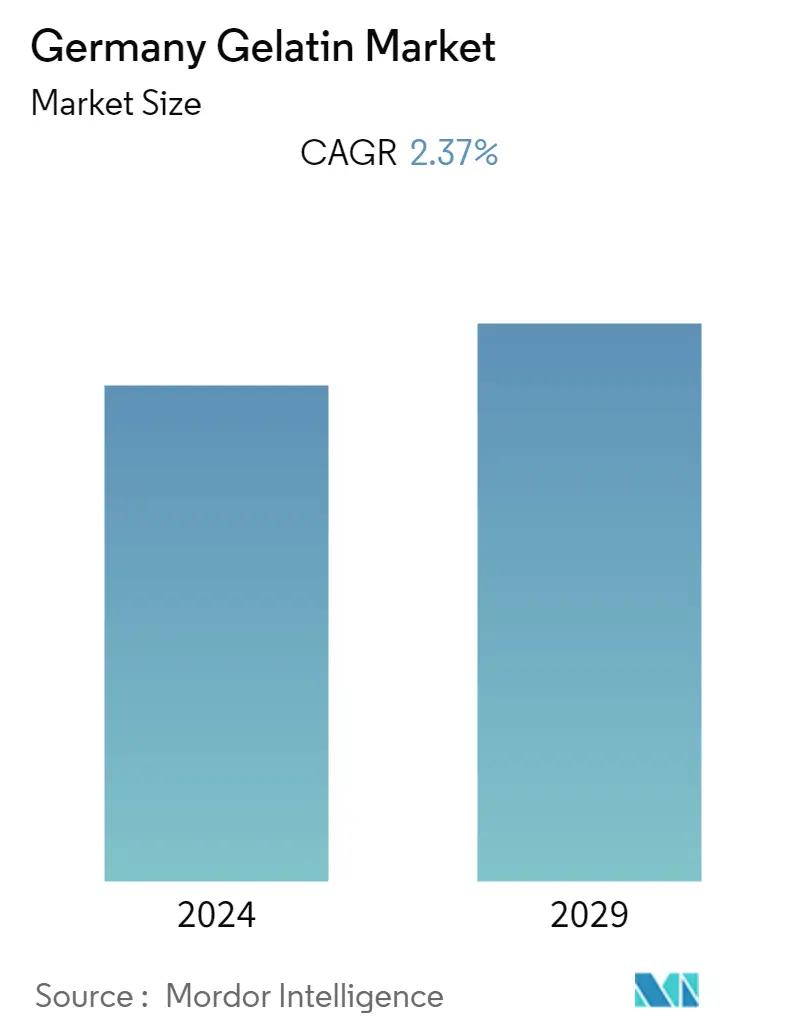Market Size of Germany Gelatin Industry

| Study Period | 2019 - 2029 |
| Base Year For Estimation | 2023 |
| Forecast Data Period | 2024 - 2029 |
| Historical Data Period | 2019 - 2022 |
| CAGR | 2.37 % |
| Market Concentration | Medium |
Major Players.webp)
*Disclaimer: Major Players sorted in no particular order |
Germany Gelatin Market Analysis
The Germany gelatin market was valued at USD 75.4 million for the current year and is projected to register a CAGR of 2.37% over the next five years.
- Gelatin is widely used in the German food industry, particularly in the confectionery segment, to produce gummy candies, marshmallows, and fruit snacks. For instance, according to the Federal Office of Statistics, the revenue of the confectionery industry in Germany was EUR 16.23 billion (USD 19.15 billion) in 2022. It is also used in the cosmetic and personal care industry to manufacture face creams, lotions, and other products due to its film-forming and texturizing properties.
- Germany is a major producer of animal-based gelatin derived primarily from collagen extracted from the skin, bones, and connective tissues of livestock, such as cattle, pigs, and poultry. The animal-based gelatin production in the country is driven by the country's well-established meat and dairy industries, generating ample by-products suitable for gelatin extraction. Gelatin manufacturers in the country use advanced technologies and strict quality control measures to produce high-quality gelatin, making them competitive in the global market.
- Furthermore, Germany is also involved in marine-based gelatin production, which is derived from collagen obtained from fish skins and scales. The marine-based gelatin production is particularly relevant to its appeal to specific consumer preferences, such as those seeking halal or kosher gelatin alternatives. Marine-based gelatin is known for its low allergenicity and its compatibility with various dietary restrictions.
- In addition, according to the Organization for Economic Co-operation and Development (OCED), almost 10% of adults between the ages of 20 and 79 years had diabetes in Germany in 2022. The increase in the aging population will drive the prevalence of cardiovascular diseases (CVDs) and other chronic diseases, which ultimately increase the consumption of gelatin products to treat such diseases.
- Germany is a significant market for gelatin and plays a crucial role in both the domestic and global gelatin industries. According to the Observatory of Economic Complexity (OEC), in 2021, Germany exported USD 266 million in gelatin, making it the 2nd largest exporter of gelatin in the world.
Germany Gelatin Industry Segmentation
Gelatin is an odorless, colorless protein substance extracted by boiling a mixture of water and the skin, bones, and tendons of animals.
The German market is segmented by form and end-user. By form, the market is segmented into animal-based and marine-based. By end-user, the market is segmented into personal care and cosmetics, food, and beverages. The food and beverages segment is further subdivided into bakery, beverages, condiments/sauces, confectionery, dairy, and dairy alternative products, RTE/RTC food products, and snacks.
The market sizing has been done in value terms in USD and volume terms in tons for all the above-mentioned segments.
| Form | |
| Animal-Based | |
| Marine-Based |
| End-User | |||||||||
| Personal Care and Cosmetics | |||||||||
|
Germany Gelatin Market Size Summary
The German gelatin market is a significant player in both domestic and global industries, driven by its extensive application across various sectors such as food, cosmetics, and pharmaceuticals. Gelatin's versatility as a gelling agent, stabilizer, and emulsifier makes it a crucial ingredient in the confectionery industry, particularly for products like gummy candies and marshmallows. The market benefits from Germany's robust meat and dairy industries, which provide ample by-products for animal-based gelatin production. Additionally, the growing demand for low-calorie and fat-free products has further propelled the market, as gelatin helps reduce fat content while maintaining taste and texture. The increasing health consciousness among consumers, coupled with the rise in chronic diseases, has also contributed to the market's expansion, as gelatin is used in various health-related applications.
The competitive landscape of the German gelatin market is characterized by the presence of both regional and multinational companies, such as GELITA AG, Rousselot, and NITTA GELATIN, INC, which are actively engaged in product innovation and strategic partnerships to enhance their market position. The market is also witnessing advancements in gelatin products tailored for specific applications, such as pharmaceuticals and cosmetics, which further drive demand. The introduction of new products, like rapid-setting gelatin and collagen peptides with anti-aging properties, highlights the industry's focus on meeting diverse consumer needs and regulatory standards. As a result, the German gelatin market is poised for steady growth, supported by its diverse applications and the ongoing development of innovative products.
Germany Gelatin Market Size - Table of Contents
-
1. MARKET DYNAMICS
-
1.1 Market Drivers
-
1.1.1 Growing Demand for Convenience and Processed Foods Drives Demand
-
1.1.2 Expanding Cosmetic and Personal Care Industries Utilize Gelatin for Various Purposes
-
-
1.2 Market Restraints
-
1.2.1 Fluctuations in Raw Material Proces Affecting Production Costs
-
-
1.3 Porter's Five Forces Analysis
-
1.3.1 Threat of New Entrants
-
1.3.2 Bargaining Power of Buyers/Consumers
-
1.3.3 Bargaining Power of Suppliers
-
1.3.4 Threat of Substitute Products
-
1.3.5 Intensity of Competitive Rivalry
-
-
-
2. MARKET SEGMENTATION
-
2.1 Form
-
2.1.1 Animal-Based
-
2.1.2 Marine-Based
-
-
2.2 End-User
-
2.2.1 Personal Care and Cosmetics
-
2.2.2 Food and Beverages
-
2.2.2.1 Bakery
-
2.2.2.2 Beverages
-
2.2.2.3 Condiments/Sauces
-
2.2.2.4 Confectionery
-
2.2.2.5 Dairy and Dairy Alternative Products
-
2.2.2.6 RTE/RTC Food Products
-
2.2.2.7 Snacks
-
-
-
Germany Gelatin Market Size FAQs
What is the current Germany Gelatin Market size?
The Germany Gelatin Market is projected to register a CAGR of 2.37% during the forecast period (2024-2029)
Who are the key players in Germany Gelatin Market?
GELITA AG, Rousselot, NITTA GELATIN, PB Gelatins Gmbh and Ewald-Gelatine GmbH are the major companies operating in the Germany Gelatin Market.

